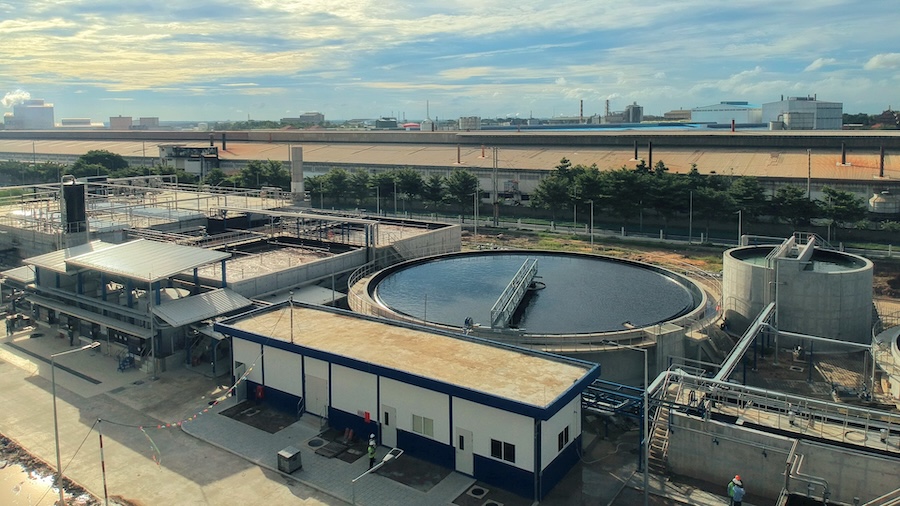As clean water resources become increasingly scarce and operating costs continue to rise, reusing treated wastewater has emerged as a practical solution for industrial plants. Not only does it help reduce the demand for freshwater and lower wastewater treatment costs, but it also demonstrates a commitment to environmental protection — aligning with green manufacturing trends and sustainable development goals. So, how does the wastewater reuse process work, and where can it be applied within a manufacturing facility?
1. Why Do Manufacturing Plants Need to Reuse Wastewater?
Water shortages are becoming more severe in many regions, particularly in areas with rapid industrial growth. Over-extraction of groundwater and surface water not only depletes resources but also leads to serious consequences such as land subsidence, pollution, and environmental degradation.
In this context, wastewater reuse after treatment is a crucial solution, helping to reduce pressure on natural water sources and improve water use efficiency in industrial operations.
Beyond environmental benefits, wastewater reuse offers manufacturers several advantages:
-
Significantly reduces operating costs.
-
Minimizes freshwater intake.
-
Lowers costs of treating discharged effluent.
Moreover, many current policies and regulations encourage the implementation of wastewater reuse systems. In line with sustainable development trends, deploying such systems not only helps businesses meet legal requirements but also enhances their brand image and demonstrates corporate responsibility toward the community and the environment.

Why do manufacturing plants need to reuse wastewater?
2. Applications of Wastewater Reuse in Manufacturing Plants
2.1. Irrigation and Industrial Cleaning
One of the most common applications of treated wastewater is landscape irrigation within factory premises, parks, or surrounding green spaces. This water can also be used for cleaning purposes such as floor washing, equipment rinsing, or spraying production areas. Utilizing treated water for these purposes not only reduces clean water consumption but also improves overall resource efficiency.
2.2. Cooling Equipment Systems
In many industrial sectors, water serves as a cooling medium for machinery, boilers, or production equipment. Treated wastewater that meets specific standards can be reused in such cooling systems, especially when combined with advanced filtration technologies like RO or UF to ensure water quality. This not only reduces new water demand but also optimizes equipment performance over time.
2.3. Reuse in Production Processes
In industries like textiles, paper, steel, or food processing (in non-contact stages), treated wastewater can be reintegrated into certain parts of the production line. This approach effectively reduces freshwater intake while complying with environmental protection standards. Manufacturers can tailor filtration and treatment processes to meet the technical requirements of each reuse stage.
3. Standard Wastewater Reuse Process
To ensure safety and effectiveness in wastewater reuse, the quality of treated water must meet specific technical standards depending on the intended application, as outlined below:
3.1. Reuse in Industrial Applications
-
pH level: 6.5 – 8.5
-
Total Suspended Solids (TSS): ≤ 30 mg/L
-
Biochemical Oxygen Demand (BOD₅): ≤ 30 mg/L
-
Chemical Oxygen Demand (COD): ≤ 75 mg/L
-
Heavy Metals: In compliance with QCVN 40:2011/BTNMT
3.2. Reuse in Agricultural Applications
-
pH level: 6.0 – 8.5
-
TSS: ≤ 50 mg/L
-
BOD₅: ≤ 50 mg/L
-
Total Nitrogen: ≤ 10 mg/L
-
E. coli: ≤ 1000 MPN/100 ml
-
Pesticide Residues: Must not exceed the limits specified in QCVN 39:2011/BTNMT
3.3. Reuse in Domestic Applications
Applicable only to treated wastewater that meets potable water standards as defined in:
-
QCVN 01-1:2018/BYT
-
Total Coliforms: ≤ 3 MPN/100 ml
-
No heavy metals exceeding permissible limits
-
Free from toxic chemicals
The wastewater reuse process at the manufacturing plant meets environmental standards
Wastewater reuse is no longer just a “must-to-have” — it is becoming an essential trend for modern industrial operations. Investing in wastewater treatment and reuse systems** not only delivers economic benefits but also plays a crucial role in conserving natural resources and enhancing a company's image in the eyes of regulators and customers alike.

.jpg)